Submitted by chandra on Thu, 2014-08-14 09:18
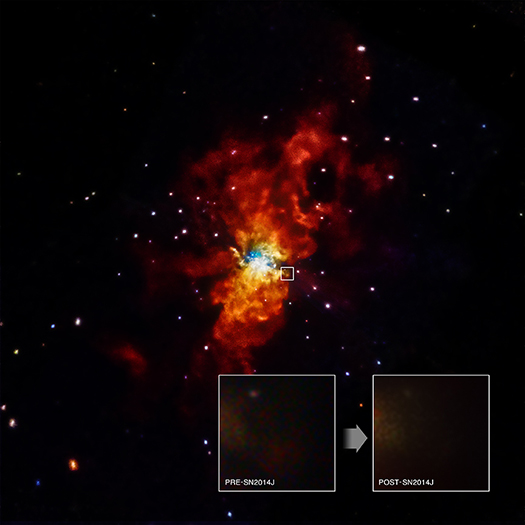
New data from NASA's Chandra X-ray Observatory has provided stringent constraints on the environment around one of the closest supernovas discovered in decades. The Chandra results provide insight into possible cause of the explosion, as described in our press release.
Submitted by chandra on Mon, 2014-07-21 18:27

Dr. Harvey Tananbaum at the Smithsonian's Castle Library in May 2006. (Credit: Jim Moran)
On April 20, 2014, Harvey Tananbaum stepped down after 23 years as director of the Chandra X-ray Center (CXC). This event was duly noted in various press releases, but its significance may not have been widely appreciated.
Submitted by chandra on Mon, 2014-07-21 16:31
A month or two after Chandra launched in July 1999, I was asked at a Chandra X-ray Center (CXC) senior staff meeting how long I actually expected Chandra to operate. I spontaneously responded: "23 years". Now that is a number not heard very frequently, so there were lots of quizzical looks indicating that an explanation was in order.
Submitted by chandra on Mon, 2014-07-21 15:06
Here is a roundup of blog articles for #astrolovers from around the web this week:
Submitted by chandra on Wed, 2014-07-02 15:09
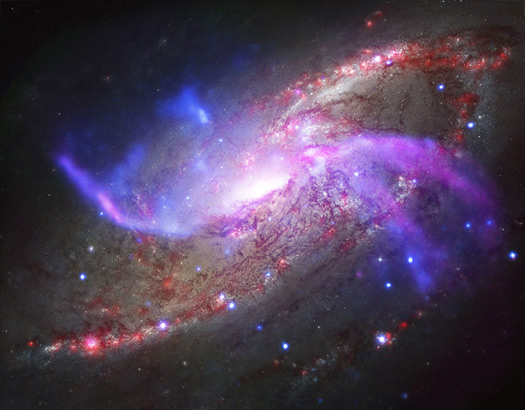
A galaxy about 23 million light years away is the site of impressive, ongoing, fireworks. Rather than paper, powder, and fire, this galactic light show involves a giant black hole, shock waves, and vast reservoirs of gas.
Submitted by chandra on Tue, 2014-07-01 10:45
 Nanda Rea. Credit: N. Rea
Nanda Rea. Credit: N. ReaLast week, the Committee on Space Research (COSPAR) announced the awards that will be presented at their upcoming meeting in August in Moscow. One of the winners of the Yakov B. Zeldovich Medals -- a joint award of COSPAR and the Russian Academy of Sciences conferred on young scientists for excellence and achievements – will go to Nanda Rea.
Dr. Rea is an assistant professor at the Institute of Space Sciences (CSIC-IEEC) in Barcelona and the Anton Pannekoek Institute (API) at the University of Amsterdam. She has spent much of her career studying magnetars, a special class of neutron stars that have some of the strongest magnetic fields in the Universe.
Submitted by chandra on Mon, 2014-06-23 13:44
We are delighted to welcome Esra Bulbul as a guest blogger. Esra led the new study reporting evidence for a mysterious X-ray signal in galaxy clusters, leading to our latest press release. She earned her master’s degree in physics from the Middle East Technical University in the capital city, Ankara, in Turkey in 2006. Four years later she graduated with a PhD in physics from the University of Alabama in Huntsville / NASA Marshall Space Flight Center. After receiving her Ph.D. she moved to the Harvard-Smithsonian Center for Astrophysics as a Smithsonian Astrophysical Fellow working jointly at the NASA Goddard Space Flight Center as a visiting scientist. She is now back at the Harvard-Smithsonian Center for Astrophysics and enjoys living in the greater Boston area.
When I started my first postdoc at the Harvard-Smithsonian Center for Astrophysics, I already knew that one alternative way to improve the sensitivity of current instruments like Chandra and XMM-Newton is to “stack” large numbers of observations of galaxy clusters, meaning that we layer one observation on top of another.
The great advantage of stacking observations is not only an increased signal-to-noise ratio (that is, the amount of useful signal compared to background noise), but also the diminished effects of detector and background features. The X-ray background emission and instrumental noise are the main obstacles in the analysis of faint objects, such as galaxy clusters.
Submitted by chandra on Mon, 2014-06-23 13:36
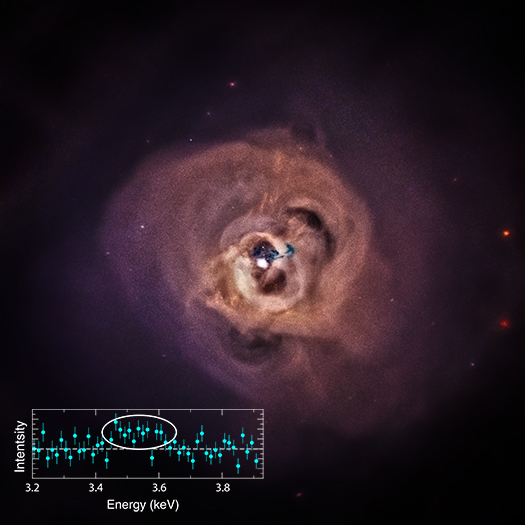
A new study of the Perseus galaxy cluster, shown in this image, using NASA's Chandra X-ray Observatory and 73 other clusters with ESA's XMM-Newton has revealed a mysterious X-ray signal in the data. This signal is represented in the circled data points in the inset, which is a plot of X-ray intensity as a function of X-ray energy. The signal is also seen in over 70 other galaxy clusters using XMM-Newton. This unidentified X-ray emission line - that is, a spike of intensity at a very specific energy, in this case centered on about 3.56 kiloelectron volts (keV) - requires further investigation to confirm both the signal's existence and nature as described in the latest Chandra press release.
Submitted by chandra on Tue, 2014-06-17 10:34
Telling a story about science can come in many different shapes, from an image of the area around a black hole, to a three-dimensional model of the remains of an exploded star, to something as simple as a tweet about a planet. Working for the Chandra X-ray Observatory, one of NASA's “Great Observatories” that studies extremely hot regions in space such as colliding galaxies and neutron stars, there is no shortage of data to tell stories about. Chandra orbits about 1/3 of the way to the Moon so it can take long exposures of cosmic objects. This year, Chandra marks its 15th anniversary of science operations out in the cold, dark and somewhat dangerous void of space.
Perhaps 50% of the job of “visualizing the X-ray Universe” is figuring out how we need to look at Chandra’s X-ray data and asking ourselves: what questions are this data trying to answer? what do experts see in this data? how will non-experts view and understand the data? The remaining 50% of the job is then what to do with that data, to make it both accessible and understandable.
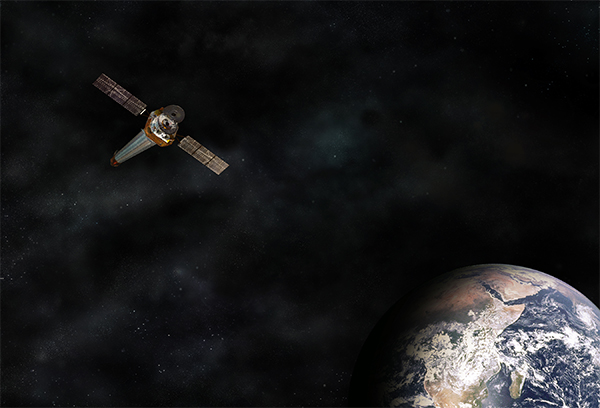
Submitted by chandra on Tue, 2014-06-03 10:30
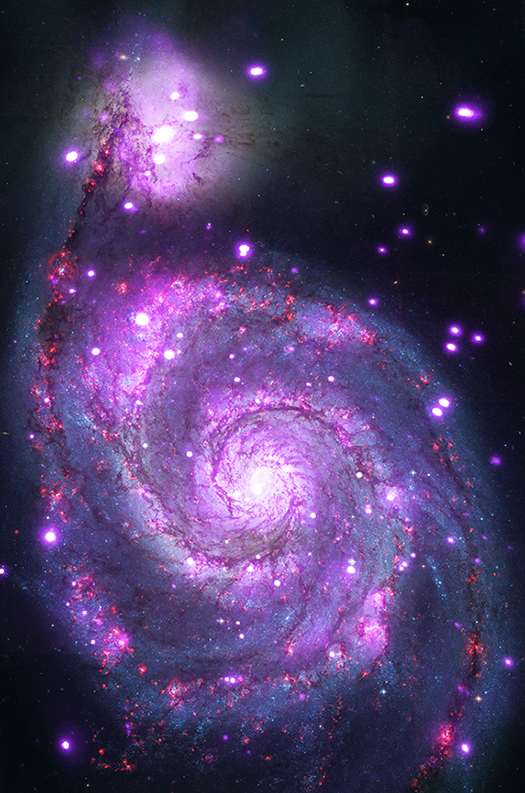
Nearly a million seconds of observing time with NASA's Chandra X-ray Observatory has revealed a spiral galaxy similar to the Milky Way glittering with hundreds of X-ray points of light.
The galaxy is officially named Messier 51 (M51) or NGC 5194, but often goes by its nickname of the "Whirlpool Galaxy." Like the Milky Way, the Whirlpool is a spiral galaxy with spectacular arms of stars and dust. M51 is located about 30 million light years from Earth, and its face-on orientation to Earth gives us a perspective that we can never get of our own spiral galactic home.
Pages